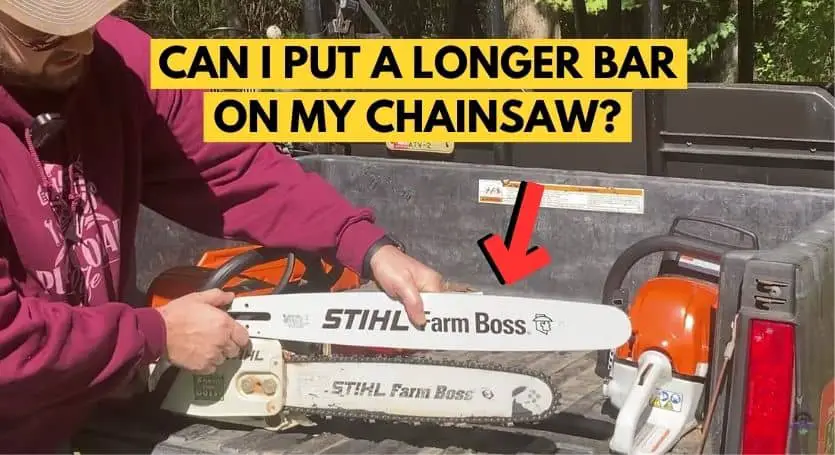
Yes, you can definitely put a longer bar on your chainsaw. However, the length of the bar you can use depends on how powerful your chainsaw is. The more power it has, the longer the bar it can handle.
Btw, I’m Samuel Anali and I have 20+ years of experience working with chainsaws. In this article, I’m going to cover –
- ✅ The maximum length of bar you can use on your chainsaw,
- ✅ Benefits and limitations of longer bars,
- ✅ How to choose the right bar length for your chainsaw,
- ✅ And at the end, how to put a longer bar on your chainsaw.
So, let’s dive right in!
Table of Contents
ToggleWhat is the Maximum Length of a Bar I can Put on My Chainsaw?
How long of a bar you can put on your chainsaw depends on the power of your saw.
For gas-powered chainsaws, it’s the engine displacement (cc), and for electric chainsaws, it’s usually the Volts (Battery-powered) or Amps (Cordless Electric).
The longer the bar, the more power your chainsaw will need to handle the load.
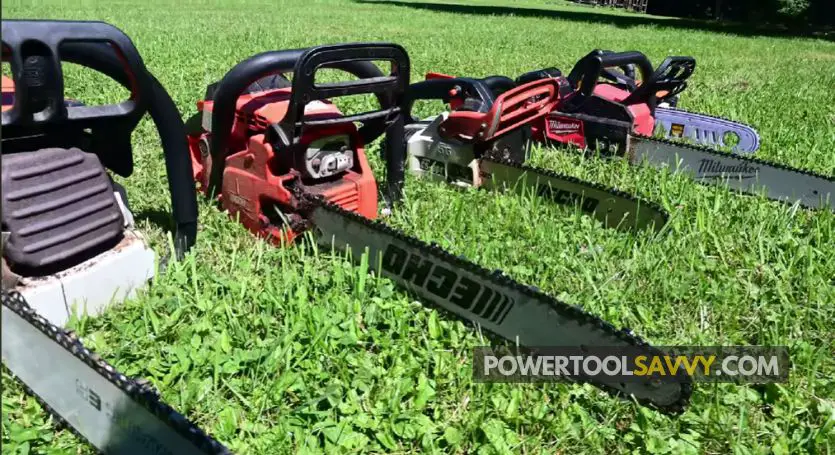
Let me make it easy for ya! 👇
Say you drive a truck that has 22.5″ tires.
Now if you want to replace those tires with bigger ones, say 24.5″ tires, you need to first make sure that the engine is powerful enough to handle those bigger tires.
Why??
Because bigger tires mean more weight and higher rolling resistance. And your truck needs to be able to cope with the extra strain.
It’s the same principle when it comes to chainsaws!
A 50cc chainsaw can easily run a bar between 16″ to 20″. But if you put a longer bar like 24″ or 28″, then it’s just too much for the saw.
Here’s a table that lists the recommended bar length based on chainsaw power rating: 👇
| Chainsaw Type | Power Rating | Recommended Bar Length |
|---|---|---|
| Gas-powered | Less than 25 cc | 10-12” |
| Gas-powered | 26-35 cc | 12-16” |
| Gas-powered | 36-45 cc | 14-20” |
| Gas-powered | 46-60 cc | 16-24” |
| Gas-powered | 60-75 cc | 18-28” |
| Gas-powered | 76-90 cc | 20-32” |
| Gas-powered | 91-100 cc | 24-36” |
| Gas-powered | 100-115 cc | 26-50” |
| Gas-powered | More than 116 cc | 28-84” |
| Battery-powered | 18-20 Volts | 10-12" |
| Battery-powered | 24-30 Volts | 10-14" |
| Battery-powered | 36-40 Volts | 10-16" |
| Battery-powered | 40-50 Volts | 12-18" |
| Battery-powered | 50-60 Volts | 12-20" |
| Corded Electric | 8-12 Amps | 10-16" |
| Corded Electric | 13-15 Amps | 12-18" |
✍️ Note: The table above is for general reference only!
I’ve gone through hundreds of chainsaw manuals to verify those numbers, so you know it’s reliable!
For the most accurate info, you should always refer to your chainsaw’s manual (it’s usually written under the “Specifications”).
Benefits of Longer Chainsaw Bars
Here comes the JUICY part! 🍺
Using a longer bar has several advantages. Here are a few of them: 👇
Less Bending
With a longer bar, you don’t have to bend as much while cutting. This not only reduces the strain on your back but also makes it easier to cut for a longer period of time. ⏱️
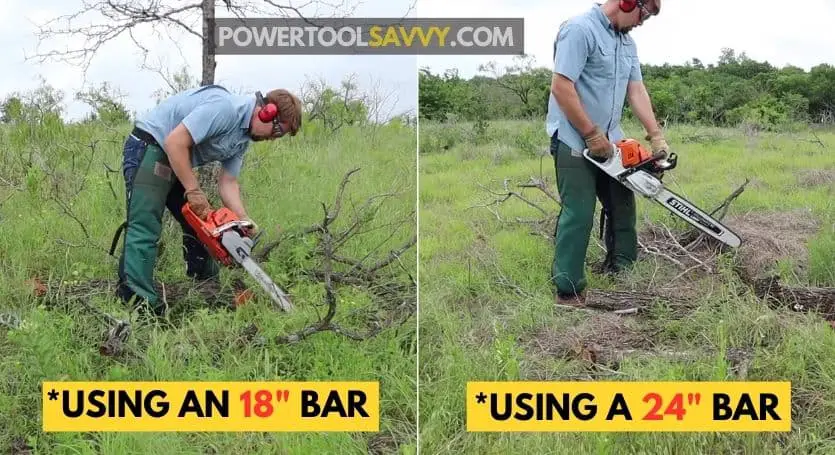
(Say goodbye to those back-bending, spine-twisting moves that make you feel like you’re auditioning for a circus act! 🤡)
Thanks to that extra length, you can stand tall and proud while you work that chainsaw magic.
When I was 21, I used to work at a sawmill in Oregon. Those days were tough and I can’t tell you how much of a relief it was to have those long bars!
Extended Reach
Next up is the reach.
Obviously, a longer bar will give you more reach!
This comes in handy when you’re trying to cut down logs that are far away.
Instead of having to move around like a madman, you can just stand in one spot and cut the log from there. 🌳 🪓
Plus, a longer bar is useful for cutting those pesky branches that were previously mocking you from a distance.
Not only does it make the job easier but also saves your time! ⏱️
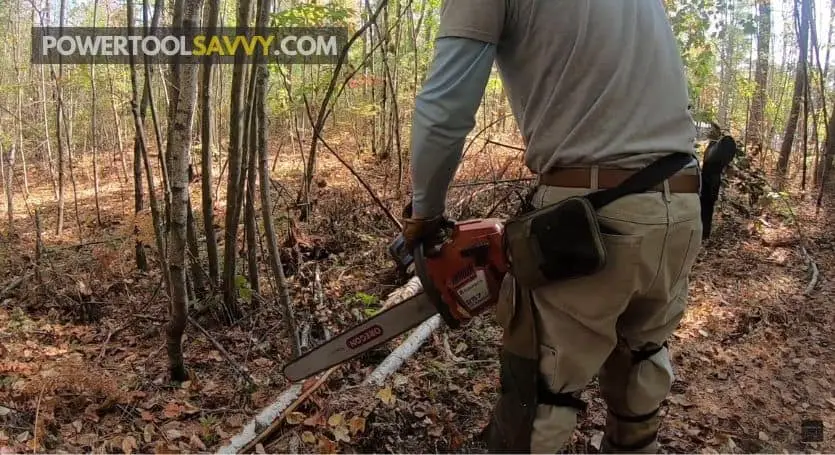
Increased Cutting Efficiency
Using a longer bar, you can take on those monster-size logs and turn them into perfectly sliced pieces with a single swoop.
(No more short, wimpy cuts that barely make a dent!)
Plus it’ll save you a lot of time and energy.
For example, if you run an 18″ bar on your saw, it would take several cuts to split a 22″ thick log into two pieces. But with a 24″ bar, you can do it in one single pass!
And that’s what I call efficiency!
Read this article to learn about the longest chainsaw bar ever made!
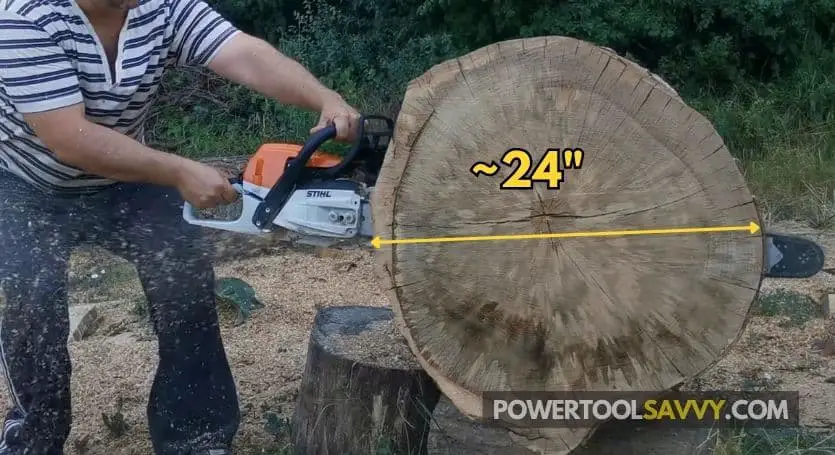
Drawbacks of Longer Chainsaw Bars
Now let’s move on to the not-so-good part! 😞
Here are 5 drawbacks of using a longer bar: 👇
Less Power
I remember the line from the movie, “With great power comes great responsibility.“
Well, with extra length comes less power!
If you put a longer bar on your chainsaw, you’ll notice a decrease in power.
This is because, a longer bar puts more strain on the engine (as now It needs to propel the chain a long way with the same power), resulting in less power output.
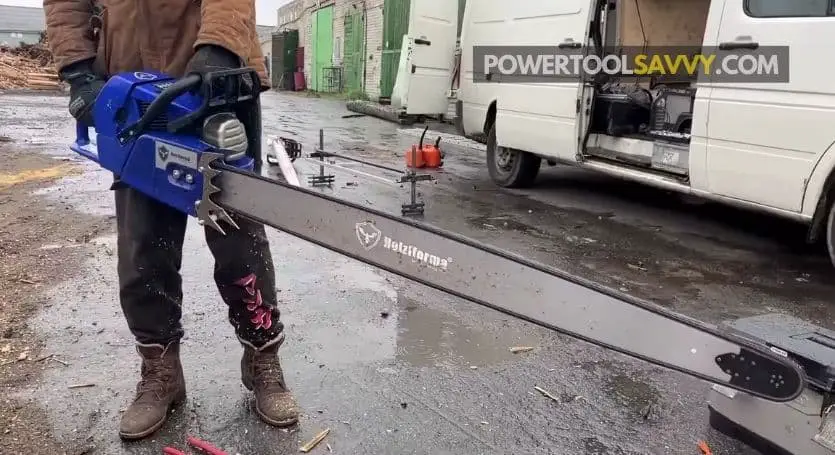
Think of it like that truck. If you end up replacing its 22.5″ tires with 24.5″ tires, the engine will require more power to push the truck, resulting in reduced acceleration and speed.
And it’s the same with your chainsaw (Longer bar = less power).
I own a Stihl MS-261. It’s a 50cc beast that can easily run a 20-inch bar with no power problems.
But I’ve always used an 18″ bar on it. Cause here in Ohio, I mostly cut hardwood and I don’t want to trade off power for length. 😎
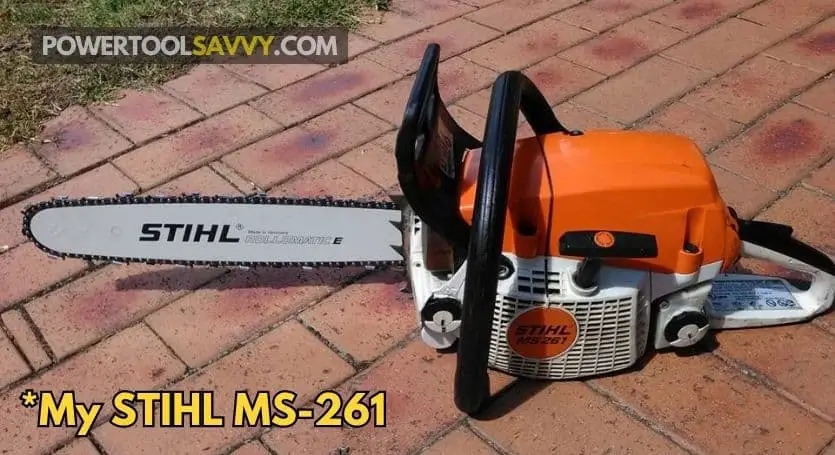
If I ever need to use a longer bar in the future, I would get a bigger saw (like a 60cc or 70cc model) to compensate for the loss of power.
Increased Weight
Yup, that’s another tradeoff you have to make when using a longer bar!
Chainsaw bars are made of heavy-duty metal. So obviously they’re going to be heavy and add more weight on your saw.
And that extra weight will make it harder for you to maneuver and balance the saw (especially in hard-to-reach spots).
Here’s a chainsaw bar length-to-weight chart to illustrate my point: 👇
| Bar Length | Added Weight |
|---|---|
| 16" | 1-1.5 lbs |
| 18" | 2-2.5 lbs |
| 20" | 2.5-3 lbs |
| 24" | 3-3.5 lbs |
| 28" | 3-4 lbs |
| 32" | 3.5-5 lbs |
| 34" | 4-5.5 lbs |
As you can see, a 32″ bar can add up to 5 lbs to the overall weight of your saw. So make sure you’re up for it before going for the longer bars!
Cost
If you’re overwhelmed by all the benefits of a longer bar and want to get your hands on one, let me tell you the truth!
Longer bars often come with a higher price tag than shorter ones because they’re larger and constructed using more robust materials.
For example, an 18″ Oregon bar will cost you around $55 while a 24″ one can set you back by $65 or more. 💸
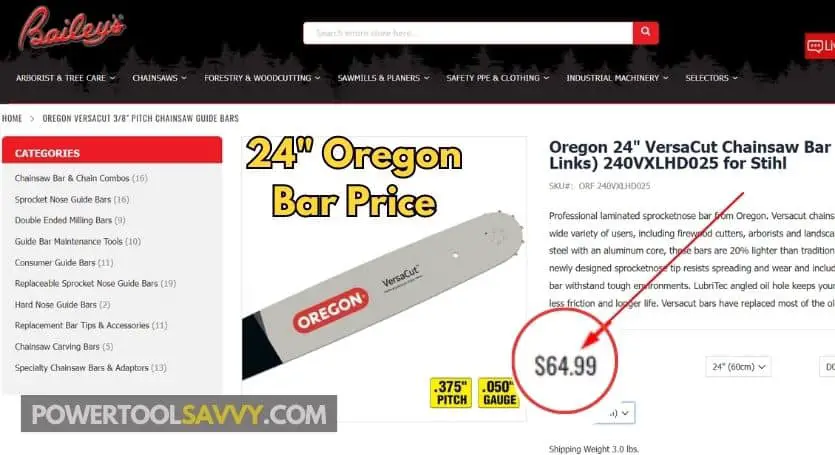
That’s not all!
You’ll also need to get a longer replacement chain that fits the new bar. Because chainsaw chains aren’t universal. And that too will cost you a good amount of money! 🤑
So before you come to a conclusion, calculate your budget accordingly.
Greater Safety Concerns
Believe it or not, longer bars can also increase certain safety hazards.
For starters, the extra length makes it more difficult to handle the saw. I mean, it gets harder to maneuver a longer bar through thick branches and logs.
Meanwhile, the increased weight can take its toll on your body. It can cause fatigue and muscle strains while you’re operating the saw.
Plus longer bars mean more leverage, and when the tip hits something unexpectedly, it can jerk the saw backward.
We definitely don’t want that surprise twist in our chainsaw adventures! (Do we??)
Oiling Issues
(One of our forum members pointed out this issue!)
When you put an extremely long bar on your chainsaw, the oiler can’t keep up with the demand.
As a result??
The bar and chain start clogging up quickly and smoking, leading to decreased performance and eventually damage.
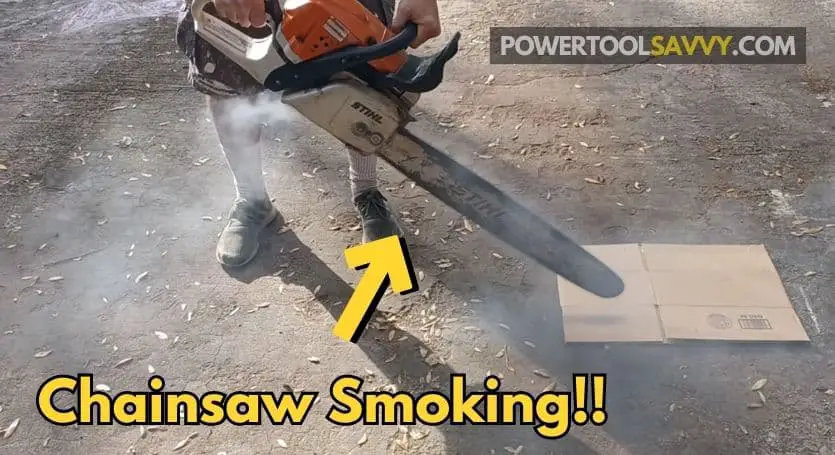
“But how do I know if my chainsaw oiler is functioning properly?“
Well, I’ve written an entire article on this topic. You can check that out here: 👉 Why is My Chainsaw Not Oiling?
How to Choose the Right Chainsaw Bar Length?
I know, some of you guys are already wondering: “What length bar should I get for my chainsaw?“
Well, the answer depends on a few factors. 👇
The Power of Your Chainsaw
I’ve already discussed this before.
The more powerful your chainsaw, the longer bar you can use.
Open up your chainsaw manual and get the power rating of your saw. Then, compare it with this chart to determine the recommended bar length for your saw.
Or under the “Specifications” section of your chainsaw manual, you’ll find the recommended bar length. (here’s an example 👇)
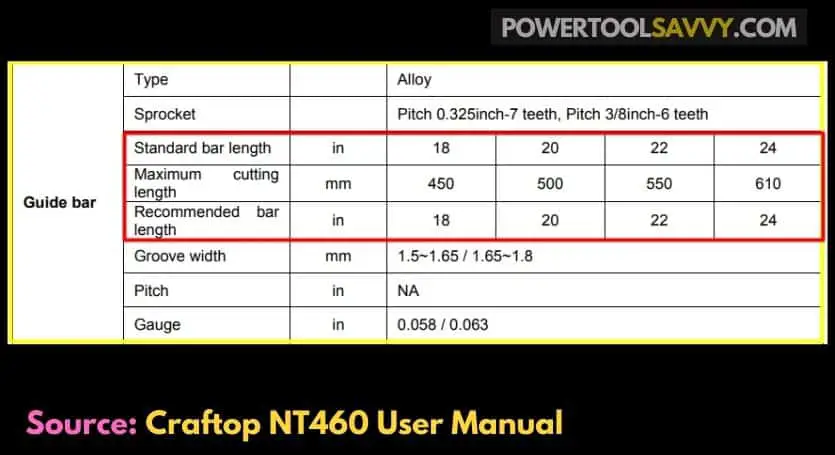
Softwood VS Hardwood
The type of wood you cut also makes a huge difference!
If you mostly cut hardwood like oak or maple, I would recommend sticking to a shorter bar.
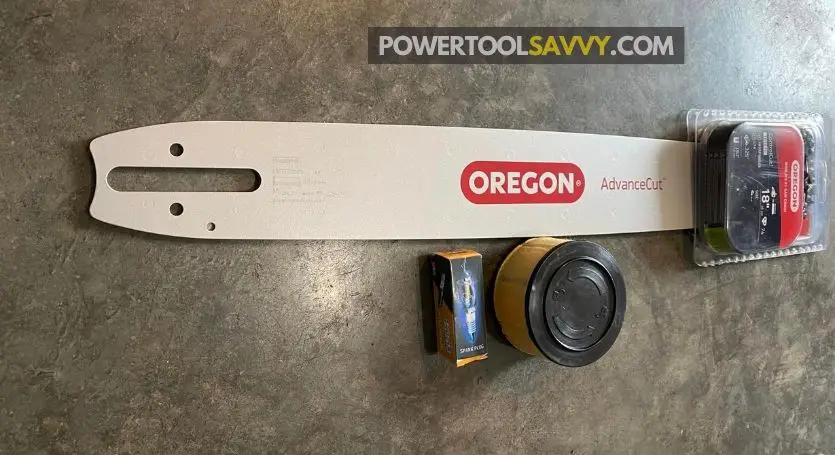
Because cutting hardwood requires more power. And as you’ve just learned, the longer the bar, the less powerful your saw becomes. (I hardly go above 20″ when cutting hardwood!)
On the other hand, if you cut softwood like pine or fir, you can go for a slightly longer bar.
These types of wood are easier to cut and don’t require as much power. So, putting a longer bar won’t be an issue.
How Experienced You Are
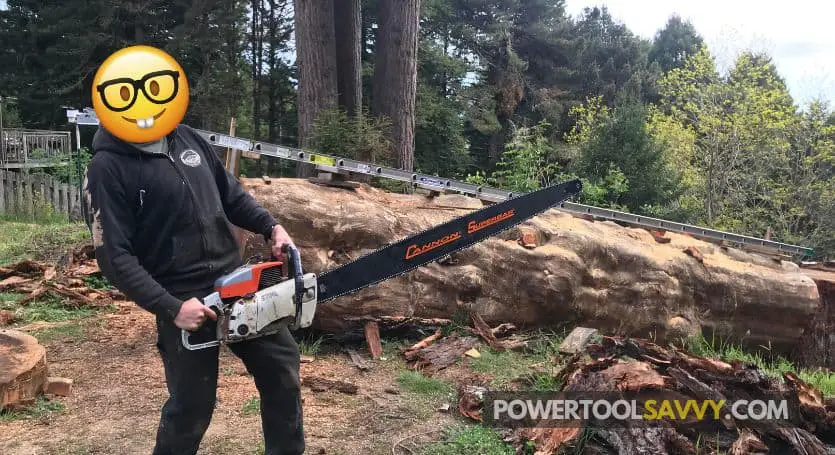
I don’t recommend beginners to go beyond 18″ bar length if they want a smooth learning experience.
Starting with a shorter bar length is like having training wheels on your chainsaw. It gives you more control and maneuverability, just like when you’re learning to ride a bike.
As you gain experience and confidence, you can start to spread your wings (or should I say bars?) and take on bigger tasks.
But for those of you who’ve already mastered the art of chainsawing, there’s no stopping you. The sky is the limit!
How to Measure a Chainsaw Bar?
Do you know the length of your chainsaw bar?
No worries!
Here are 2 easy methods to figure it out: 👇
Method 1: Look for Markings on the Bar
If you pay close attention 👀, you’ll notice that almost all the chainsaw guide bars out there have some markings engraved/printed on them.
They can be anywhere from the middle to the end of the bar.
These markings usually display the length of the bar, along with some other crucial details such as the pitch and the gauge.
Don’t get confused!
The length is expressed in inches/cm (like 18″/45cm, 20″/50cm, etc) and written in large letters. (here’s an example 👇)
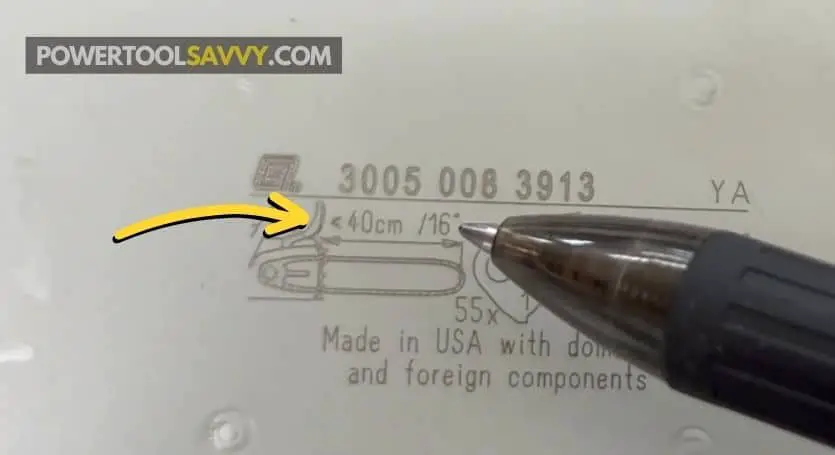
Method 2: Measure It Yourself
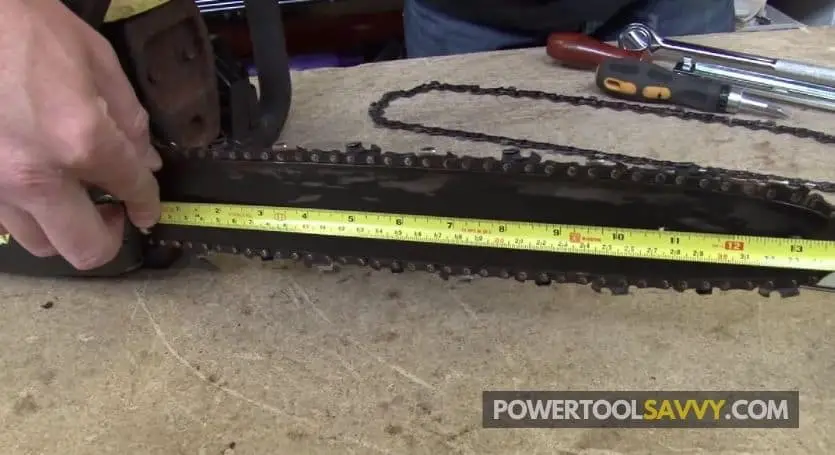
In case your bar doesn’t have any markings, or you just want to be sure, you can measure it yourself with a measuring tape.
Here’s the step-by-step guide to measuring a chainsaw bar: 👇
- Grab a measuring tape.
- Next, start measuring from the tip of the bar to the point where it meets the chainsaw body (power head).
- Make sure you’re measuring it along its middle portion. This is the longest part of the bar and will give you a more accurate measurement.
- If you get an odd number, like 17.5 inches (for example), just round it off to the nearest even number (18 in this case). Because chainsaw bars are only available in whole-number sizes (14″, 16″, 20″, etc).
And that’s how you measure the length of a chainsaw bar. Easy, right?
“But how to measure a bar that’s off the saw?“
The process is almost the same. Just measure the bar from the tip to the center slot (where it meets the drive sprocket) and round off to the nearest even integer.
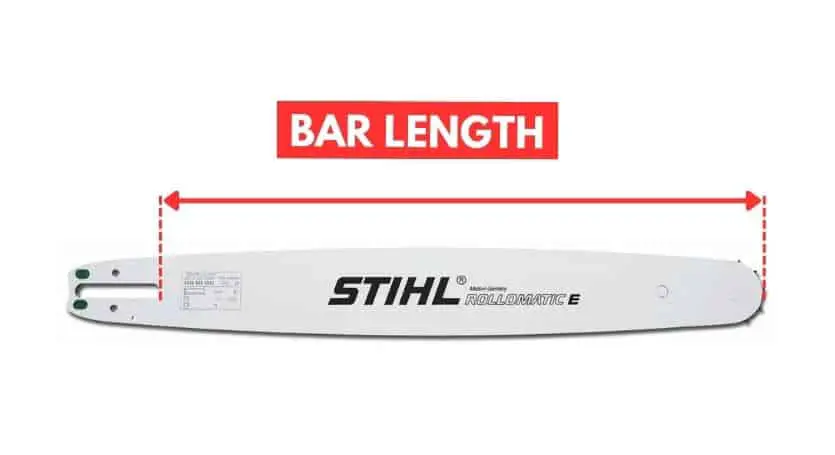
✍️ Note: Some Stihl bars don’t follow the “cutting length” rule. They’re measured from the tip to the end of the bar, which may give you a different result.
So make sure to check the manual or manufacturer’s website for specific bar length details.
How to Put a Longer Bar on a Chainsaw?
Let’s say you’ve convinced your mind and your wife that you need a longer bar, but how do you actually put the new bar on?
No worries!
The only tool you’ll need is a scrench (a special tool that combines a screwdriver and a wrench).
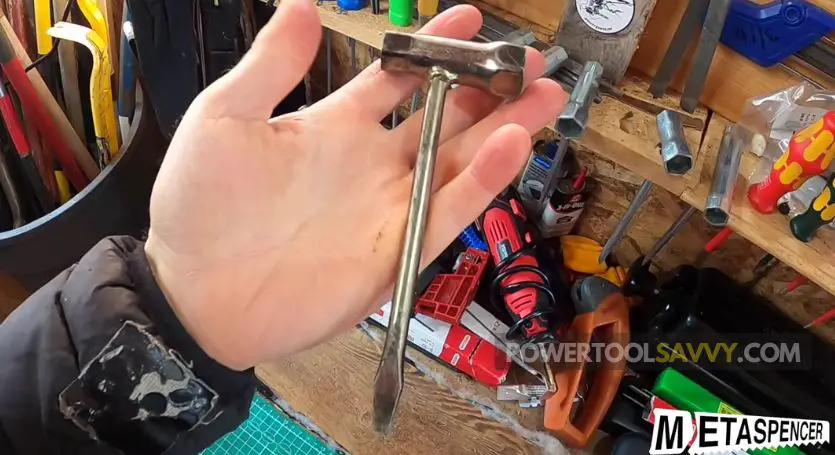
Here’s a step-by-step guide on how to install a longer bar on a chainsaw. 👇
Step 1: First thing first, make sure your saw is turned off, the chain brake is disengaged, and the spark plug is disconnected.
Step 2: Grab the scrench and use its flathead screwdriver end to loosen the chain tensioning screw. It’s usually located either on the front (A) or side cover (B).
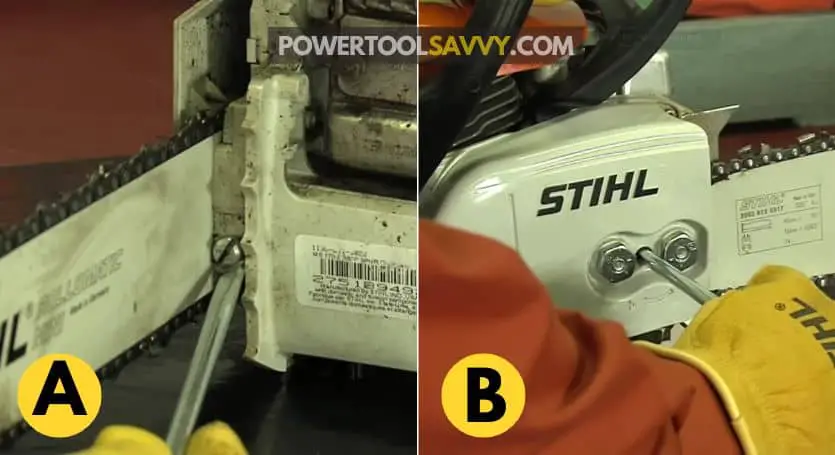
Step 3: Now loosen the bar nuts and take off the clutch cover. This’ll give you access to the chain and guide bar. (Don’t lose the nuts!)
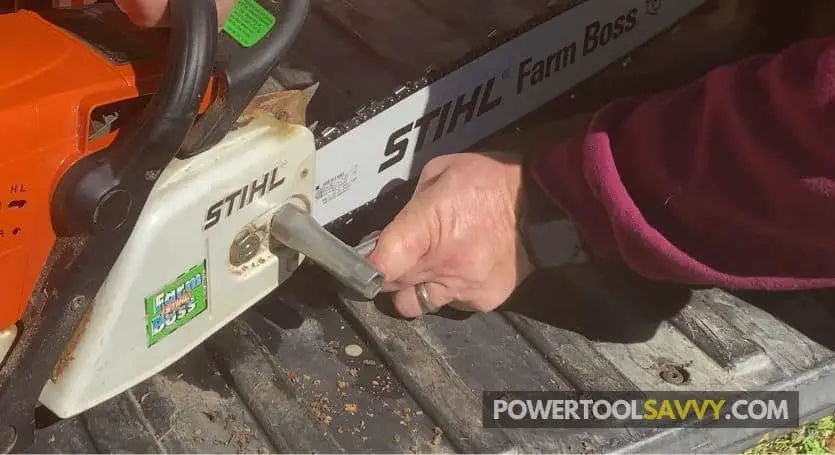
Step 4: Carefully remove the old chain and guide bar.
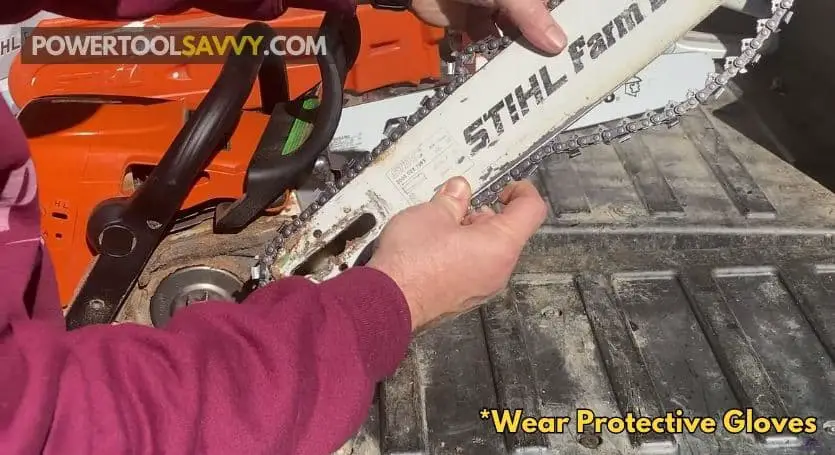
Step 5: Grab that longer bar you’ve got, place the bar onto the bar bolts, and slide it all the way back. Make sure it lines up perfectly with the drive sprocket and those nifty oiler holes.
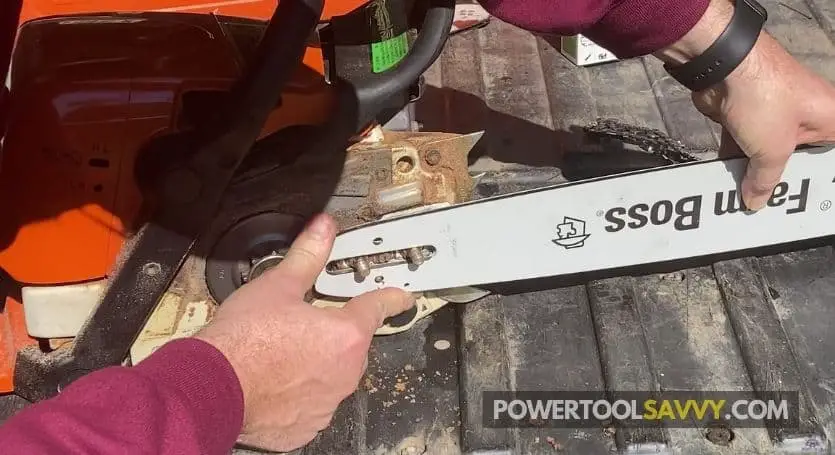
Step 6: Place the chain over the drive sprocket, making sure the cutting teeth are facing toward the tip of your bar (Correct Chainsaw Chain Direction). Next, fit the chain around the bar.
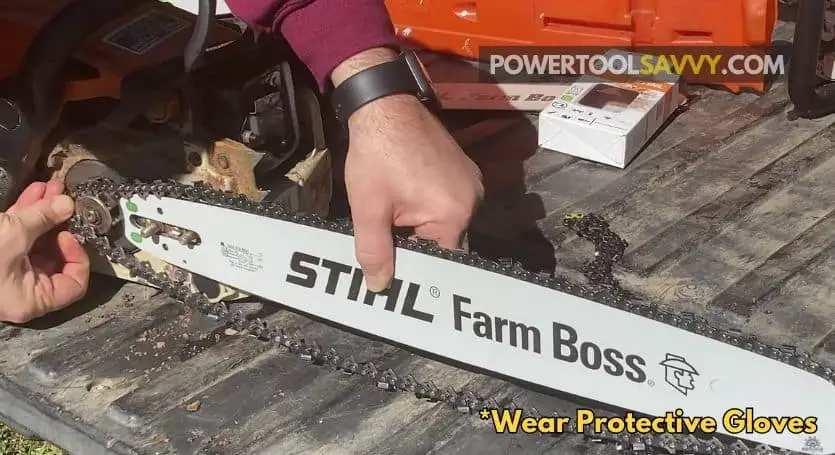
Step 7: Once the chain is properly seated on the bar, put the clutch cover back and tighten the bar nuts finger-tight. You need to align the chain tensioning pin with the hole in the bar.
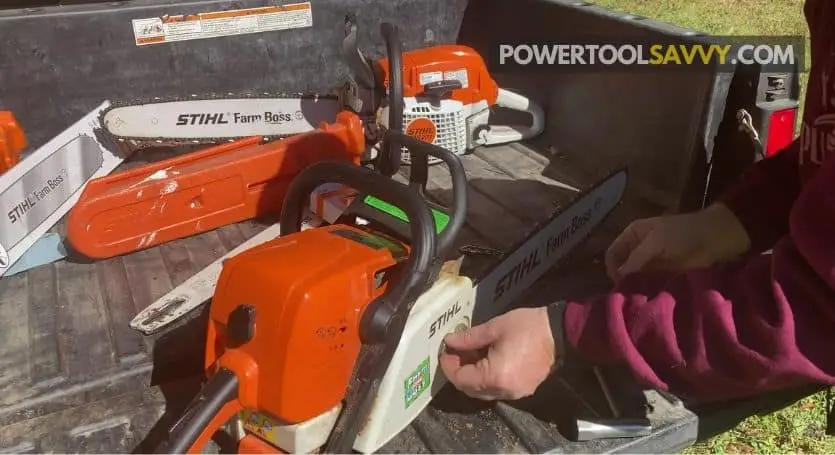
Step 8: Tension the chain by turning the chain tensioning screw clockwise using the scrench while holding the tip of the bar. The chain is properly tensioned when the bottom of the drive can’t be visibly lifted over the bar but the chain moves freely around the bar (not too tight, not too loose!).
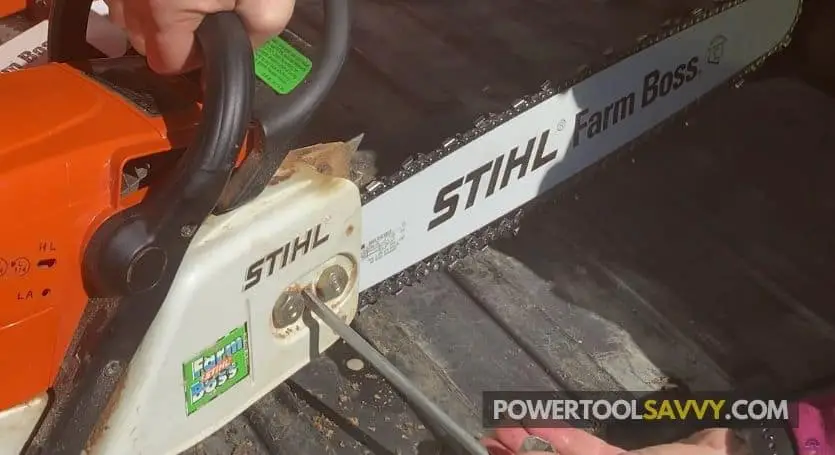
Step 9: Tighten the bar nuts with the scrench. Don’t over-tighten!
That’s it!
If you liked this article, let us know in the comments! We’d love to hear from you. 😀
Happy sawing!
Also Read:

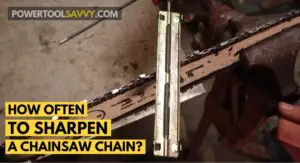
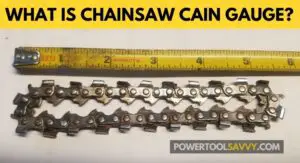
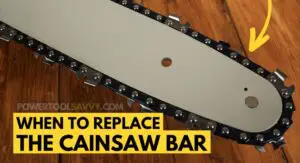
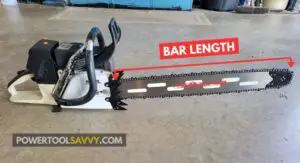

Pingback: Can I Put a Smaller Bar on My Chainsaw? (If YES, How Small?)
Pingback: Chainsaw Bar Length VS CC Chart (Last Updated: June, 2023)
Pingback: Top Handle VS Rear Handle Chainsaw (Price, Weight, Safety)
Pingback: How to Measure a Chainsaw Bar Length? (3 EASY Steps!)
Pingback: The Longest Chainsaw Bar Ever Made (Updated: 2023)